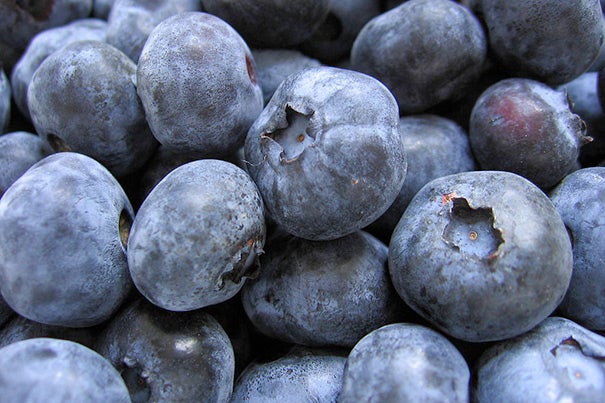
People who ate at least two servings each week of certain whole fruits — particularly blueberries, grapes, and apples — reduced their risk for type 2 diabetes by as much as 23 percent in comparison to those who ate less than one serving per month.
Photo by Jeff Kubina
Skip the juice, go for whole fruit
Eating whole fruits, particularly blueberries, grapes, apples, linked to lower risk of type 2 diabetes
Eating more whole fruits, particularly blueberries, grapes, and apples, was significantly associated with a lower risk of type 2 diabetes, according to a new study led by Harvard School of Public Health (HSPH) researchers. Greater consumption of fruit juices was associated with a higher risk of type 2 diabetes. The study is the first to look at the effects of individual fruits on diabetes risk.
“While fruits are recommended as a measure for diabetes prevention, previous studies have found mixed results for total fruit consumption. Our findings provide novel evidence suggesting that certain fruits may be especially beneficial for lowering diabetes risk,” said senior author Qi Sun, assistant professor in the Department of Nutrition at HSPH and assistant professor of medicine at the Channing Division of Network Medicine, Brigham and Women’s Hospital.
The study appears online Aug. 29 in BMJ (British Medical Journal).
The researchers examined data gathered between 1984 and 2008 from 187,382 participants in three long-running studies (Nurses’ Health Study, Nurses’ Health Study II, and Health Professionals Follow-Up Study). Participants who reported a diagnosis of diabetes, cardiovascular disease, or cancer at enrollment were excluded. Results showed that 12,198 participants (6.5 percent) developed diabetes during the study period.
The researchers looked at overall fruit consumption, as well as consumption of individual fruits: grapes or raisins; peaches, plums, or apricots; prunes; bananas; cantaloupe; apples or pears; oranges; grapefruit; strawberries; and blueberries. They also looked at consumption of apple, orange, grapefruit, and “other” fruit juices.
People who ate at least two servings each week of certain whole fruits — particularly blueberries, grapes, and apples — reduced their risk for type 2 diabetes by as much as 23 percent in comparison to those who ate less than one serving per month. Conversely, those who consumed one or more servings of fruit juice each day increased their risk of developing type 2 diabetes by as much as 21 percent. The researchers found that swapping three servings of juice per week for whole fruits would result in a 7 percent reduction in diabetes risk.
The fruits’ glycemic index (a measure of how rapidly carbohydrates in a food boost blood sugar) did not prove to be a significant factor in determining a fruit’s association with type 2 diabetes risk. However, the high glycemic index of fruit juice — which passes through the digestive system more rapidly than fiber-rich fruit — may explain the positive link between juice consumption and increased diabetes risk.
The researchers theorize that the beneficial effects of certain individual fruits could be the result of a particular component. Previous studies have linked anthocyanins found in berries and grapes to lowered heart attack risk, for example. But more research is necessary to determine which components in the more beneficial fruits influence diabetes risk.
“Our data further endorse current recommendations on increasing whole fruits, but not fruit juice, as a measure for diabetes prevention,” said lead author Isao Muraki, research fellow in the Department of Nutrition at HSPH. “And our novel findings may help refine this recommendation to facilitate diabetes prevention.”
Other HSPH authors are JoAnn Manson, professor in the Department of Epidemiology; Frank Hu, professor of nutrition and epidemiology; Walter Willett, Fredrick John Stare Professor of Epidemiology and chair of the Nutrition Department; and Rob van Dam, adjunct associate professor of nutrition and epidemiology.
Support for the study came from research grants from the National Institutes of Health. Sun was supported by a career development award from the National Heart, Lung and Blood Institute.




